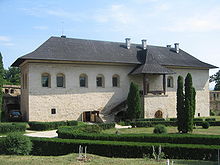Cetățuia Monastery
- View a machine-translated version of the Romanian article.
- Machine translation, like DeepL or Google Translate, is a useful starting point for translations, but translators must revise errors as necessary and confirm that the translation is accurate, rather than simply copy-pasting machine-translated text into the English Wikipedia.
- Do not translate text that appears unreliable or low-quality. If possible, verify the text with references provided in the foreign-language article.
- You must provide copyright attribution in the edit summary accompanying your translation by providing an interlanguage link to the source of your translation. A model attribution edit summary is
Content in this edit is translated from the existing Romanian Wikipedia article at [[:ro:Mănăstirea Cetățuia din Iași]]; see its history for attribution. - You may also add the template
{{Translated|ro|Mănăstirea Cetățuia din Iași}}to the talk page. - For more guidance, see Wikipedia:Translation.
The Cetățuia Monastery (Romanian: Mănăstirea Cetățuia) is a Romanian Orthodox monastery located in Iași, Romania. The monastery is listed in the National Register of Historic Monuments.[1]
History

Located on the top of Cetățuia Hill of the old Moldavian capital, the monastery was built by Prince Gheorghe Duca in the 17th century.[2]

The monastery is surrounded by fortifications with towers on the corners. In the past, it provided refuge during enemy siege or full-scale invasions. The name itself, Cetățuia, means citadel or fortress in Romanian.
The uniqueness of Cetățuia Monastery consists in the fact that the entire ensemble of monastic architecture has been preserved.[3]
A special place is the palace destined to the lodging of the prince, a fortified building characteristic to the 17th century and the kitchen or, according to other opinions, the Turkish bath, which is the only construction of this kind that has been preserved within a monastic ensemble.
In addition there is also a gothic hall, a museum of medieval art, a tower called "Pilgrim’s Dinner", from where one can admire the panorama of Iași and its famous wine cellars with wine obtained from its own vineyard.[4]
Gallery
References
External links

- "Churches and monasteries in Iași". Iași City Hall website. Archived from the original on 2011-07-26.
- v
- t
- e
- Balș House
- Braunstein Palace
- Calimachi Palace
- Cantacuzino-Pașcanu Palace
- Cuza Palace
- Grand Hotel Traian
- Grigore Sturdza Palace
- Metropolitan Palace
- Mihai Sturza Palace
- Neuschotz Palace
- Palace of Culture
- Roset-Roznovanu Palace
- Art Museum
- Dosoftei House
- Ethnographic Museum of Moldavia
- George Topîrceanu Memorial House
- Iași Athenaeum
- Iași National Theatre
- Ion Creangă Bojdeuca
- Luceafărul Theatre
- Ludic Theatre
- Metropolitan Museum
- Mihai Codreanu Memorial House
- Mihai Eminescu Museum
- Mihail Sadoveanu Memorial House
- Moldavia's History Museum
- Moldova Philharmonic Orchestra
- Jewish Community Museum
- Municipal Museum
- Museum of the Alexandru Ioan Cuza University
- Natural History Museum
- Nicolae Gane Memorial House
- Otilia Cazimir Memorial House
- Pogor House
- Poni-Cernătescu Memorial House
- Romanian National Opera
- Science and Technology Museum
- Theatre Museum
- Union Museum
churches
and synagogues
- Armenian Church
- Aroneanu Monastery
- Barnovschi Church
- Bărboi Monastery
- Bârnova Monastery
- Bucium Monastery
- Cetățuia Monastery
- Frumoasa Monastery
- Galata Monastery
- Golia Monastery
- Great Synagogue
- Hlincea Monastery
- Metropolitan Cathedral
- Old Catholic Cathedral
- Old Metropolitan Cathedral
- Saint Nicholas Princely Church
- Saint Sabbas Church
- Saint Spiridon Church
- Socola Monastery
- Trei Ierarhi Monastery
- Alexandru Ioan Cuza University
- Gheorghe Asachi Technical University
- George Enescu National University of Arts
- Grigore T. Popa University of Medicine and Pharmacy
- Ion Ionescu de la Brad University of Life Sciences
- Central University Library
- Gheorghe Asachi Iași County Library
- National College
- Costache Negruzzi College
- Mihai Eminescu College
and monuments
- Alexandru Dimitrie Xenopol Statue
- Alexandru Ioan Cuza Statue
- Attacking Cavalryman Statue
- Dosoftei Statue
- Gheorghe Asachi Statue
- Grigore III Ghica Monument
- Independence Statue
- Mihai Eminescu Statue
- Mihail Kogălniceanu Statue
- Miron Costin Statue
- Stephen the Great Statue
- Union Monument
- Vasile Alecsandri Statue
- Voievodes Statuary
natural landmarks
- Bârnova Lime Tree
- Botanical Garden
- Central Market Square
- Ciric Park
- Copou Gardens
- Eminescu's Linden Tree
- Exhibition Park
- Independence Square
- Mihai Eminescu Square
- Odd Poplars Alley
- Palace Square
- Palas Garden
- Podu Roș Square
- Repedea Hill Fossil Site
- Theatre Square
- Union Square
- University Square
- Voievozilor Square
- Era Shopping Park
- Felicia Shopping Centre
- Hala Centrală
- Iulius Mall
- Moldova Center
- Palas Mall
- Iași International Airport
- Central Railway Station
- Nicolina International Railway Station
- CTP Iași
- Attractions
- Media in Iași



























